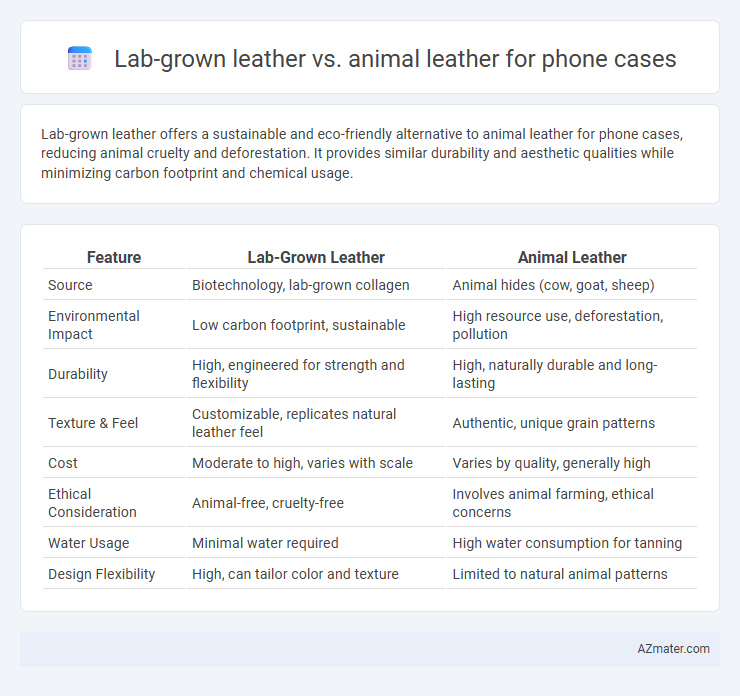Lab-grown leather offers a sustainable and eco-friendly alternative to animal leather for phone cases, reducing animal cruelty and deforestation. It provides similar durability and aesthetic qualities while minimizing carbon footprint and chemical usage.
Table of Comparison
| Feature | Lab-Grown Leather | Animal Leather |
|---|---|---|
| Source | Biotechnology, lab-grown collagen | Animal hides (cow, goat, sheep) |
| Environmental Impact | Low carbon footprint, sustainable | High resource use, deforestation, pollution |
| Durability | High, engineered for strength and flexibility | High, naturally durable and long-lasting |
| Texture & Feel | Customizable, replicates natural leather feel | Authentic, unique grain patterns |
| Cost | Moderate to high, varies with scale | Varies by quality, generally high |
| Ethical Consideration | Animal-free, cruelty-free | Involves animal farming, ethical concerns |
| Water Usage | Minimal water required | High water consumption for tanning |
| Design Flexibility | High, can tailor color and texture | Limited to natural animal patterns |
Introduction: The Evolution of Phone Case Materials
Lab-grown leather offers a sustainable alternative to traditional animal leather, reducing environmental impact while maintaining durability and luxury. Advanced biofabrication techniques produce lab-grown leather with consistent texture and strength, ideal for premium phone cases. Animal leather, known for its natural grain and long-lasting quality, faces ethical and ecological challenges that lab-grown alternatives aim to address.
What is Lab-Grown Leather?
Lab-grown leather, also known as biofabricated or cultivated leather, is produced by cultivating animal cells in a controlled environment without the need to raise and slaughter animals. This innovative material mimics the texture, durability, and appearance of traditional animal leather while significantly reducing environmental impact through lower water usage, greenhouse gas emissions, and deforestation. Lab-grown leather offers sustainable and ethical advantages especially for phone cases, combining high-quality craftsmanship with a lower ecological footprint compared to conventional animal leather.
Traditional Animal Leather: An Overview
Traditional animal leather for phone cases is derived from the hides of cows, pigs, or other livestock, known for its durability, natural texture, and unique aging patterns. It undergoes tanning processes using chrome or vegetable-based chemicals to enhance flexibility and water resistance while retaining a distinctive scent and feel. Despite ethical and environmental concerns surrounding animal leather, it remains prized for its strength, luxurious appearance, and ability to develop a patina over time.
Environmental Impact: Lab-Grown vs Animal Leather
Lab-grown leather for phone cases significantly reduces environmental impact by lowering greenhouse gas emissions, water usage, and land consumption compared to animal leather production. Animal leather involves extensive cattle farming, contributing to deforestation, methane emissions, and toxic chemical waste from tanning processes. Lab-grown leather offers a sustainable alternative by utilizing cultured cells and biofabrication technologies, minimizing ecological footprint while maintaining durability and aesthetic appeal.
Durability and Longevity Comparison
Lab-grown leather for phone cases offers enhanced durability due to its consistent molecular structure, resisting wear and tear better than traditional animal leather. Animal leather, while naturally tough, can degrade faster when exposed to moisture and UV light, leading to cracks and discoloration over time. The longevity of lab-grown leather cases typically surpasses animal leather, maintaining aesthetic appeal and structural integrity after prolonged use.
Aesthetics and Customization Options
Lab-grown leather offers a smooth, consistent texture with customizable colors and patterns that surpass the natural variations found in animal leather, allowing for unique and personalized phone case designs. The non-porous surface of lab-grown leather ensures vibrant prints and finishes, enhancing aesthetic appeal while reducing imperfections common in animal leather. Animal leather provides a classic, timeless look with natural grain patterns valued for their authenticity, but customization options are limited compared to the versatile styling possibilities of lab-grown leather.
Ethical Considerations and Animal Welfare
Lab-grown leather for phone cases significantly reduces animal cruelty by eliminating the need to raise and slaughter animals, addressing major ethical concerns linked to traditional animal leather production. It minimizes environmental impact and promotes sustainable resource use, aligning with growing consumer demand for cruelty-free alternatives. Choosing lab-grown leather supports animal welfare by preventing habitat disruption and reducing the exploitation associated with conventional leather sourcing.
Cost Analysis: Lab-Grown vs Animal Leather Phone Cases
Lab-grown leather phone cases typically offer lower production costs due to scalable manufacturing processes and reduced material waste compared to traditional animal leather. Animal leather involves higher expenses related to livestock maintenance, tanning, and environmental regulations, driving up the overall price of phone cases. Consumers often find lab-grown leather alternatives more cost-effective while maintaining durability and aesthetic appeal.
Market Availability and Consumer Adoption
Lab-grown leather for phone cases is rapidly gaining market availability due to increasing sustainable fashion trends and investments by key industry players like Modern Meadow and Bolt Threads. Consumer adoption is driven by growing environmental concerns and demand for cruelty-free products, resulting in expanding e-commerce platforms and retail partnerships offering lab-grown leather options. While traditional animal leather maintains a strong presence due to established supply chains and consumer familiarity, the lab-grown alternative is poised for significant growth in niche and mainstream markets.
Future Trends in Leather Alternatives for Phone Cases
Lab-grown leather offers a sustainable and ethical alternative to animal leather in phone cases, benefiting from advancements in biotechnology that enable scalable production with minimal environmental impact. Future trends indicate increased consumer demand for cruelty-free, biodegradable materials combined with enhanced durability and aesthetic versatility, driving innovation in lab-grown composites. Industry projections highlight a shift towards integrating smart materials and customizable textures, positioning lab-grown leather as a leading solution in eco-conscious phone case manufacturing.

Infographic: Lab-grown leather vs Animal leather for Phone case
 azmater.com
azmater.com